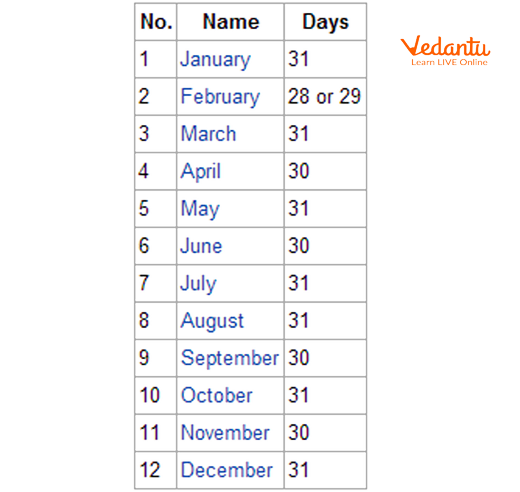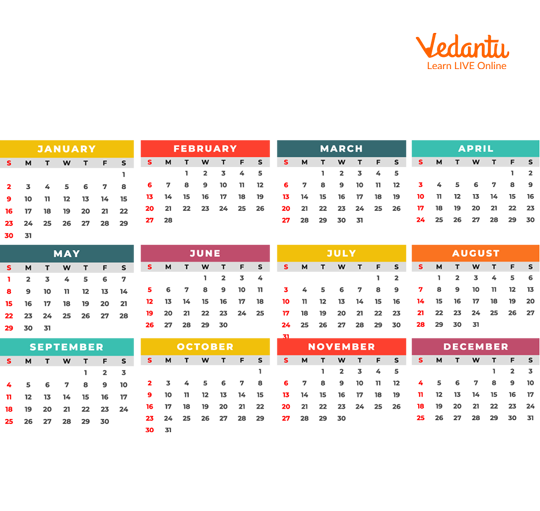




Why Are There 12 Months in a Year? Explained for Kids
Throughout the year we survive on days and months. So, understanding the total months and how many days are there in a year is necessary. The different days, weeks, and months comprise a year, which makes up our calendar system.
Here are the months of the year list that one can have a look at below:
January
February
March
April
May
June
July
August
September
October
November
December

Total Months of The Year
These total months of the year contain different numbers of days in different months and the numbers of the days vary according to the different months listed above.
Exception in Months of the Year
There are 365 or 366 days in a year depending on if the year is a normal one or a leap year. The number of days generally accounts for just 30 or 31 days but there is one exception in the year.
February is considered to be an exception among the 12 months of the year. The month of February contains 28 or 29 days depending on the type of year which is going on - a normal one or a leap year. Hence, unlike every other month containing 30 or 31 days, February is considered an exception to the year.
How to Remember the Days of the Month?
Now that you know how many days are there in a year, you need to remember how many days are there in the different months of the year. Every month contains a different number of days, hence remembering them accurately can be troubling. However, one can surely notice how the days are common in alternate months.
For example, both January and March contain 31 days while April and June contain 30 days each. Given below is the list of months containing both 30 and 31 days each.

Calendar
There are several tricks to remember which months contain 30 or 31 days. One of the easiest and most convenient methods is to use the knuckles of our fists to know which months have 31 days.
People can know that the months which are present on the knuckle contain 31 days while the months which come between the knuckles have 30 days in the year. But one should remember to start with January on the first knuckle and should move forward respectively or else the result might vary.
Understanding Leap Year
There are a total of 365 days in a year but there are 366 days once every four years. The year containing 366 days is called a leap year. The leap year has one extra day which is added to the month of February, making the month have 29 days.
Some of the leap years in the past few years were: 1996, 2000, 2004, 2008, etc. There is a method through which one can find the year which might be considered as a leap year after the year 2000. One knows there are 52 weeks in a year with one extra day remaining.
According to the Calendar
7 days constitute 1 week whereas 52 weeks make up 1 year.
12 months compile to make 1 year while 365 days also combine to make a year and 366 days combine to make a leap year.
Summary
Some of the important points in this article ‘how many months make a year’, for one to remember regarding the days and months of the year are
The years which belong from the 1900s to 1999 are regarded as the twentieth century.
The years which belong to 2000 to 2099 are regarded as the twenty-first century.
Every 1000 years makes one millennium.
FAQs on How Many Months Are in a Year?
1. How many months are there in the year?
There are 12 months in a year according to the Gregorian calendar, which is the most widely used calendar system today. The months are:
- January
- February
- March
- April
- May
- June
- July
- August
- September
- October
- November
- December
2. Is a year 12 or 13 months?
A year is typically 12 months long in the Gregorian calendar. However, some ancient or specialized calendars, such as the Ethiopian calendar and certain lunar calendars, have 13 months. For most modern academic and civil purposes, including all content provided by Vedantu, a year consists of 12 months.
3. Do they have 13 months in a year?
Some calendar systems, like the Ethiopian calendar and certain lunar calendars, do have 13 months in a year. However, the Gregorian calendar, which is used internationally and in educational systems like Vedantu's, has 12 months in a year. The 13-month system is rare and not used for mainstream purposes.
4. What is 1 trillion years called?
There is no specific term for 1 trillion years in the same way we have for decade (10 years), century (100 years), or millennium (1,000 years). In mathematics and science taught by Vedantu, large numbers of years are typically expressed in scientific notation, such as $1 \times 10^{12}$ years for a trillion years. These extremely large spans of time are mainly used in astronomy and theoretical science discussions.
5. What are the names of all 12 months in a year and how many days do they have?
The 12 months in the Gregorian calendar and the number of days in each are:
- January – 31 days
- February – 28 days (29 days in a leap year)
- March – 31 days
- April – 30 days
- May – 31 days
- June – 30 days
- July – 31 days
- August – 31 days
- September – 30 days
- October – 31 days
- November – 30 days
- December – 31 days
6. Why does February have fewer days than other months?
February has 28 days (29 in a leap year) due to historical changes in the Roman calendar. When the Julian and later Gregorian calendars were established, days were adjusted to synchronize with the solar year. To balance the total number of days, February was made shorter. Vedantu's educators explain these fascinating calendar facts through fun history and math lessons.
7. What is a leap year and how does it affect the number of months or days?
A leap year is a year with 366 days instead of the usual 365. This extra day is added to February, making it 29 days long. Leap years occur every 4 years to keep the calendar in alignment with the Earth's orbit around the Sun. The number of months stays the same at 12, but February has one additional day. Vedantu provides easy explanations and activities to help students understand leap year concepts in detail.
8. How do different cultures count months in a year?
Different cultures may use different calendar systems:
- Gregorian calendar: 12 months (internationally used, including at Vedantu)
- Lunar calendars: Some, like the Hebrew and Islamic calendars, adjust months based on the lunar cycle and occasionally add a leap month.
- Ethiopian calendar: 13 months—12 have 30 days each, and the 13th has 5 or 6 days.
9. How can students easily remember the number of days in each month?
A popular way for students to remember the number of days in each month is by using the knuckle mnemonic or the rhyme:
"Thirty days hath September, April, June, and November. All the rest have thirty-one, except for February alone."
Vedantu provides engaging activities and memory games that make learning the days in each month fun and accessible for all learners.
10. What is the mathematical basis for dividing a year into 12 months?
Dividing the year into 12 months has a mathematical and astronomical basis. The Earth's orbit around the Sun takes about 365.24 days (1 year), and ancient civilizations noticed that 12 lunar cycles (months) fit approximately into one solar year. Thus, dividing the year into 12 months created a practical way to organize time for agriculture and civil life. Vedantu's math educators help students explore these concepts by connecting mathematics with history and science.





















